Even before surface-to-air missiles went to sea, there was interest in fitting them with nuclear warheads. Surprisingly, this had less to do with trying to take out multiple targets at once, unlikely as air combat tactics adapted to the threat of nuclear warheads, and more to do with increasing the probability of a kill, particularly in the face of heavy ECM, which could be expected to push miss distances out past the limits of conventional proximity fuzes.
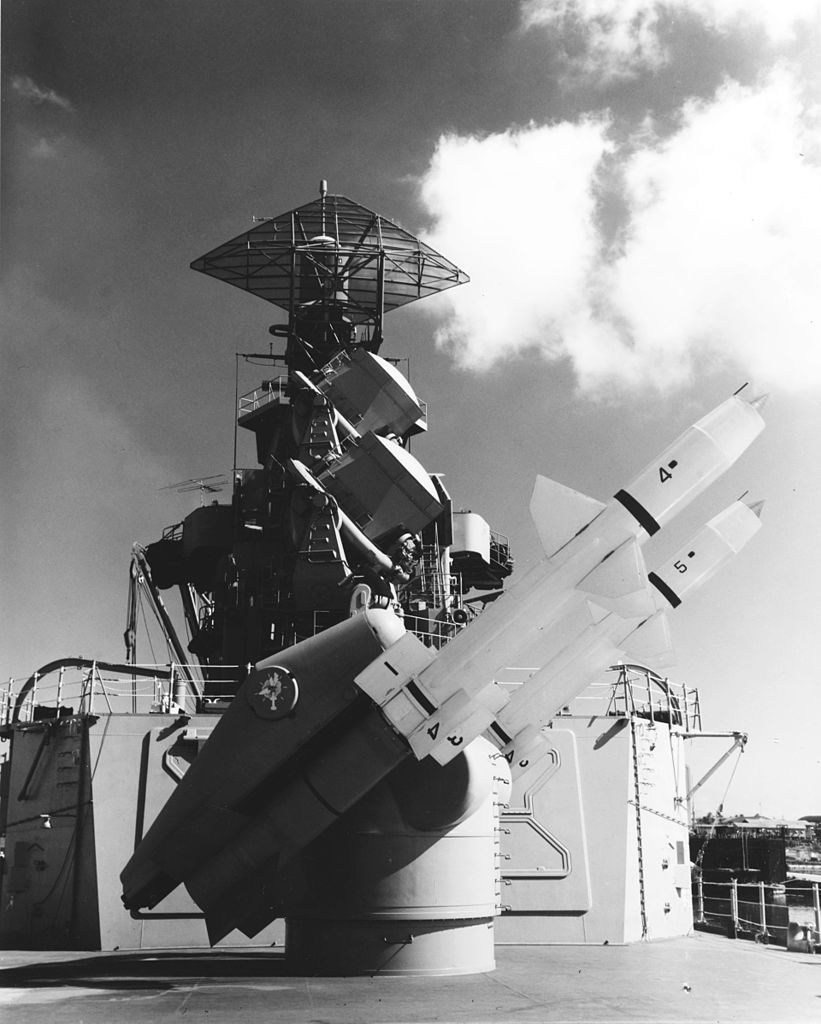
Talos missiles aboard Little Rock
A secondary benefit was the ability of a nuclear warhead to damage enemy nuclear weapons beyond its normal damage radius, thanks to an effect known as preinitiation. This happens when neutrons begin a chain reaction before the fissile material is fully compressed, and can cut the yield of a megaton bomb to only a few kilotons for as much as five minutes after the first weapon goes off. Initially, plans were made to fit Talos with a warhead version of the Mk 12 nuclear bomb, although more for use in the planned land-based variant that would be used by both the Army and Air Force. In the Army's hands, it would be used both for shooting down airplanes and as a surface-to-surface missile, but both services eventually gave up on Talos, leaving it as an all-Navy show. The W12 warhead died fairly quickly as well, as it was too heavy, and a new warhead was developed for the missile, the 5 kiloton1 W30.
This warhead would give the missile a lethal radius of 1-2000', probably varying considerably depending on the type of aircraft and its aspect towards the detonation.2 This was enough to help mitigate one of the major flaws in the conventional Talos. Its homing system couldn't distinguish between targets that were within a few hundred feet of each other, and tended to split the difference and fly between them, leaving both aircraft well out of its lethal radius. This problem was hardly unique to Talos, and American aircraft in Vietnam took advantage of the same effect to deal with SA-2s, but even the threat of nuclear SAMs could force the attackers to spread out enough that this wouldn't be an issue.
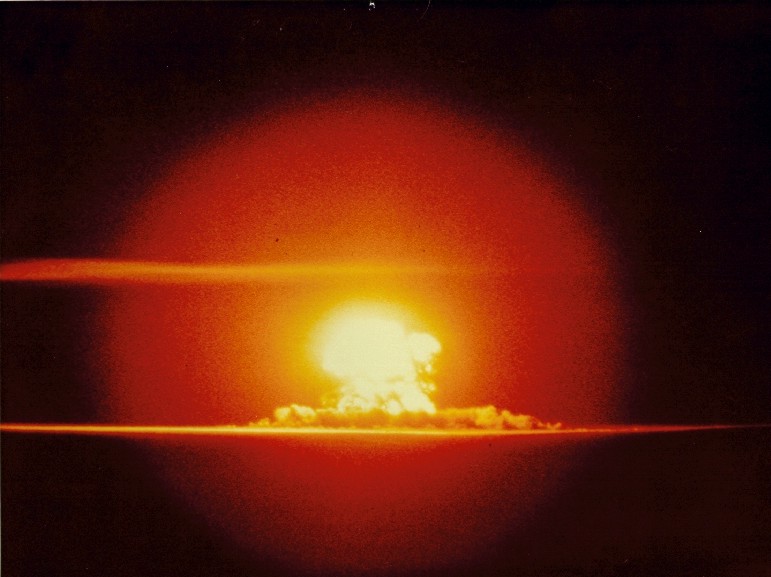
Test of the Talos W30 warhead
Ironically, the nuclear Talos wouldn't actually suffer from this problem. Due to American concerns about positive control over nuclear weapons, the nuclear Talos was a purely beam-riding weapon, and could be distinguished from its homing counterpart by the single probe on the nose, as opposed to the four-probe inferometer array used on the homing Talos. The nuclear warhead itself was installed in the nose, forming the compressor for the ramjet that propelled the missile. It was heavier than the conventional warhead, reducing the missile's ability to maneuver, but this was acceptable given the much larger lethal radius. Despite the advantages of the nuclear Talos, they soon began to pose a problem due to the limited magazine capacity of the ships that carried them. In the late 50s, it became increasingly clear that nuclear weapons might not be able to be used freely, and each nuclear Talos was one less missile that could be used in a conventional war. The solution, available thanks to improvements in electronics since Talos was first developed, was the so-called Unified Talos, a missile that could carry either type of warhead and swap them out at sea. These missiles had the inferometer array even when fitted with a nuclear warhead, although it's likely it wasn't used with the W30 installed.
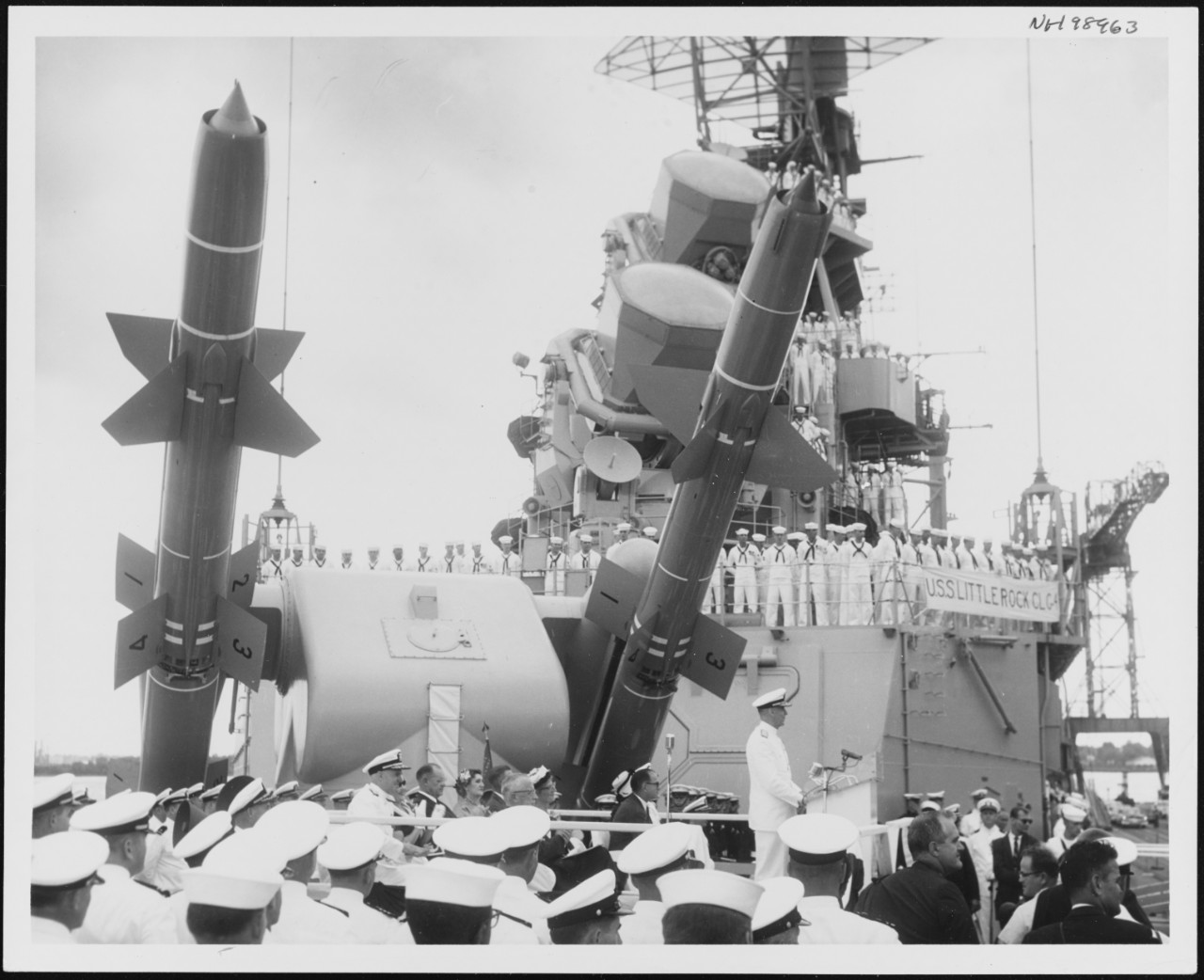
Little Rock displays one conventional and one nuclear Talos at her commissioning
As nuclear warheads shrank throughout the 50s, work began to fit one to the Terrier as a complement to the nuclear Talos. This would use the W45 warhead, shared with the Bullpup and Little John missiles. Yield was around 1 kT, giving a reported kill radius of 1,200'.3 750 of these warheads were built, as opposed to only 300 W30s, and they entered service in October 1962. As with Talos, only beam-riding guidance was used. No nuclear warhead ever seems to have been considered for Tartar, probably due to the lack of beam-riding guidance and the launchers not having appropriate access. In service, the W45 proved troublesome, suffering from problems with plutonium corrosion and deterioration of its high explosives. The worst was a miscalulation of the effects of Tritium decay, which meant that it needed frequent refreshment to make its designed yield.
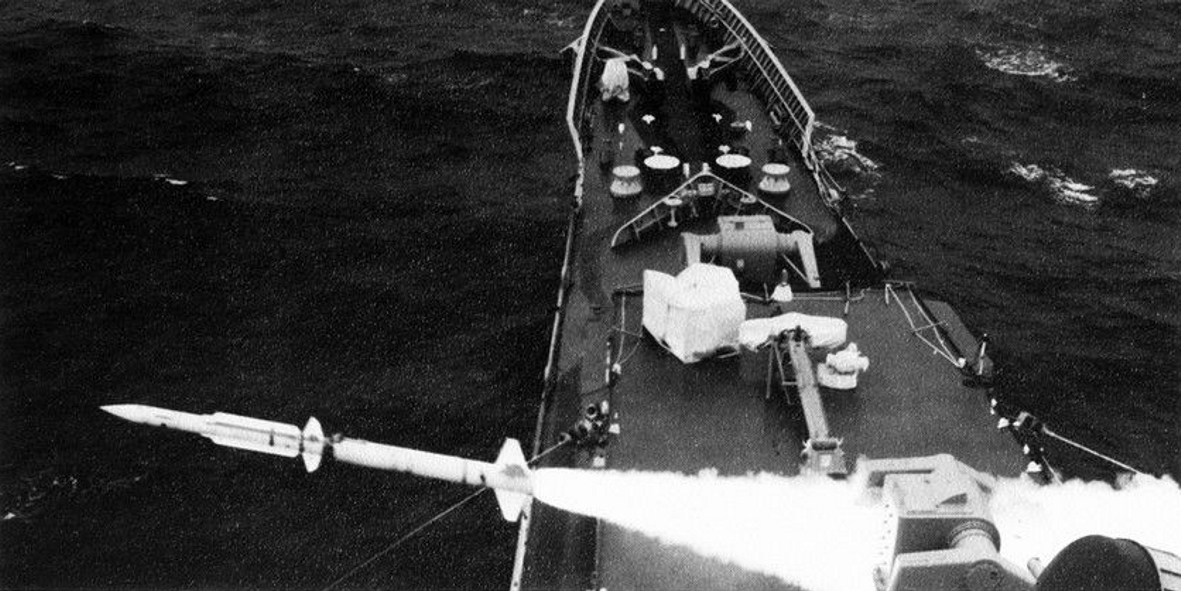
Long Beach fires a Terrier
Two different plans were made for a successor to the W30 and W45, although neither came to fruition. First, the Typhon missile, the intended successor to the 3Ts, was to be fitted with the new W60. This warhead did not have an easy gestation, with fire-safety issues twice forcing redesign. Ultimately, it was cancelled along with Typhon in 1963. Swords of Armageddon reports that yield was very low and lethal radius against aircraft was only 50', but this seems unlikely, as this is no more than a conventional warhead could manage at a much lower cost and with less hassle. Later, as the W45-armed Terrier neared the end of its service life, plans were made to replace it with a nuclear warhead for the SM-2.4 This warhead, the W81, was based on the ubiquitous B61 nuclear bomb. Initial plans were for it to be an enhanced-radiation weapon, probably to more effectively attack nuclear-armed cruise missiles, but these were scrapped, and it became a pure fission device instead. Yield was never disclosed, and the program was cancelled in 1986 when Congress cut off funding, citing the capability of Aegis. Two years later, the last W45s were retired.
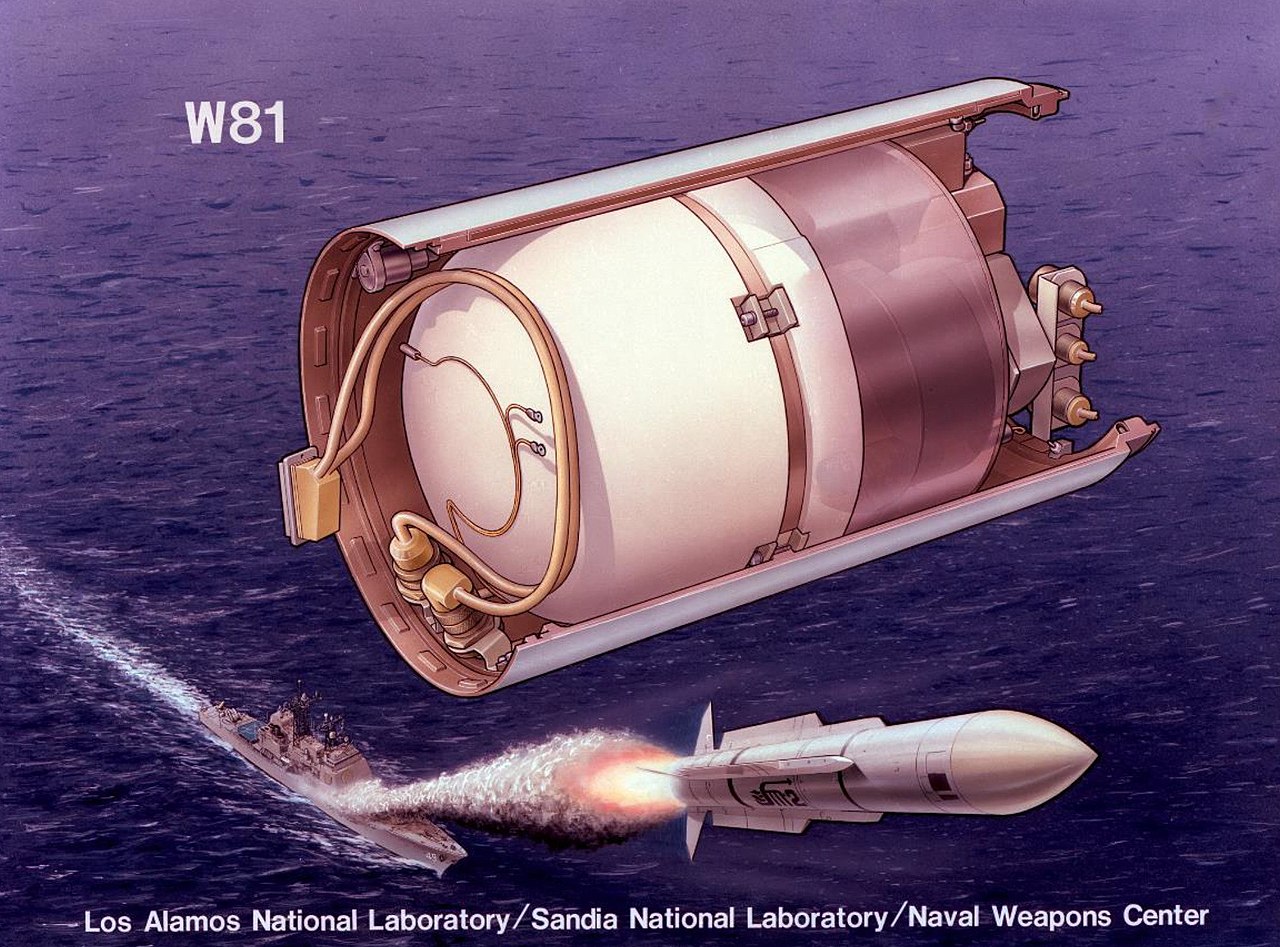
A drawing of the W81
It's not entirely clear if other countries took nuclear SAMs to sea, as both Britain and the Soviet Union may have done so, but reports are conflicting. Some Cold War-era reference books cite possible nuclear warheads for the SA-N-6/S-300, SA-N-1 and SA-N-3 missiles, although it appears that only the first of these missiles ever actually had nuclear capability. Even then, it's entirely possible that only the land-based version of the S-300 had nuclear capability, although it's not really clear either way. The situation for the British is even more muddled. It is clear that they began work on a nuclear version of the Seaslug missile, a contemporary of Terrier, and it exercised a major influence on the design of the County class destroyers that carried it. However, it appears that several different nuclear warheads were canceled, and the weapon never deployed. A nuclear warhead for the follow-on Sea Dart was discussed, but looks to have been scrapped early on in development.
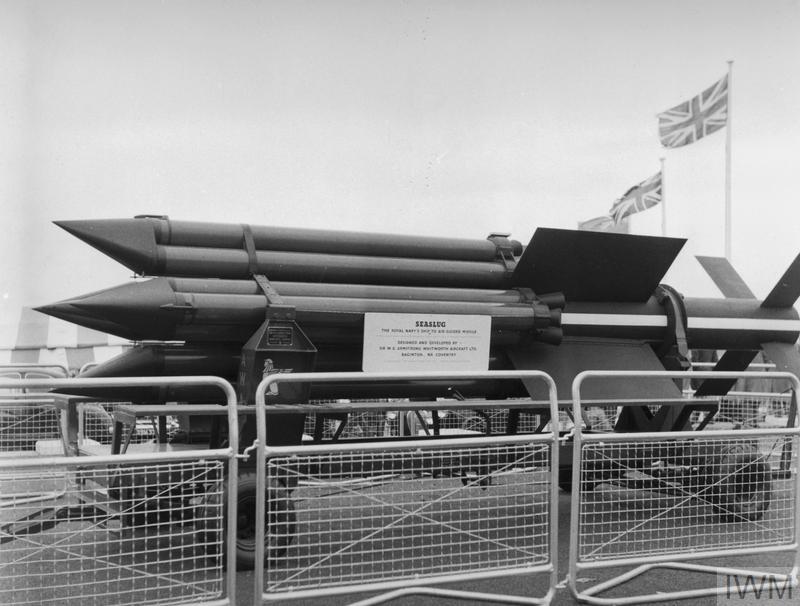
Seaslug missile on display
But the abortive nuclear Seaslug does illustrate one of the major factors in the development of nuclear SAMs. All of these warheads were intended to give the ships that carried them valuable secondary capabilities against surface targets, either afloat or ashore. Particularly for the first generation of SAMs, the limitations of their beam-riding guidance systems made direct hits on surface targets dubious, but they could easily get a nuclear warhead close enough to do serious damage. The capability provided by nuclear SAMs was seen as particularly important in light of the retirement of the battleships, which had previously served as the last line of defense against surface attack in conditions where aircraft couldn't operate. The fact that the missiles were integral to the surface force also meant that they were seen as useful in shore-bombardment roles. All of this meant that the decision was taken in 1956 to remove the 5" guns from future US missile ships in favor of dual Terriers, which was not looked on as fondly with the benefit of hindsight when free use of nuclear weapons became less acceptable in the early 60s. Fortunately, by this point semi-active homing and fuzing improvements meant that even conventional SAMs had reasonable capability against surface targets, particularly important in the face of the emerging threat of missile boats. The only major drawback was limited range, thanks to the inability of radar illuminators to reach past the horizon.5 Unfortunately, this didn't work against surface targets, which were hidden in reflections from the land around them.6
Ultimately, the nuclear SAM was, like so many other sea-based nuclear weapons, a casualty of both political limitations on their use and improvements in conventional weaponry that rendered them far less important. But in their heyday, they were a vital and often overlooked part of naval armament.
1 Sometimes reported as 4.7 kT, although some sources indicate that there was either sub-kiloton or there was an alternate sub-kiloton version. Reported lethal radius suggest that the larger figures are probably correct. ⇑
2 Jet aircraft are significantly less vulnerable than propeller-driven ones, and planes nose-on towards the blast are harder to kill than ones side-on. Information from AMCP 706-161 indicates that the actual values may be somewhat higher, if we assume the larger warhead is correct. ⇑
3 This corresponds well with the data from AMCP 706-161. ⇑
4 Many sources say that this was only to be fitted to the SM-2ER (Terrier replacement), but given the commonality between the SM-2ER and SM-2MR, this is unlikely. A drawing from Los Alamos shows a Mk 26-armed Ticonderoga launching the weapon, and Norman Friedman reports that the ability of the Mk 26 to handle nuclear-tipped missiles was a factor in its selection over the Mk 13 for the Ticos. ⇑
5 Amusingly, when fired against big ships, it was discovered that the most effective way to use Talos was to disable the warhead entirely and just let it run into the target. It was an extremely large supersonic missile, and with the limited range possible in surface-to-surface mode, it would still have a lot of fuel onboard. ⇑
6 The British were able to use the beam-riding Seaslug as a bombardment weapon in the Falklands by flying it to a specific point, then telling the autopilot to put the missile into a 45° dive. ⇑

Comments
Amusingly, when fired against big ships, it was discovered that the most effective way to use Talos was to disable the warhead entirely and just let it run into the target. It was an extremely large supersonic missile, and with the limited range possible in surface-to-surface mode, it would still have a lot of fuel onboard.
I can see that this would be effective, but why would it be more effective?
Why would a big fast thing, with loads on fuel on board, cause more damage than a big fast thing, with loads of fuel on board, plus a big explosion?
The warhead is intended for anti aircraft use, so detonates at some distance from the target. The burning fuel isn't as dense as the shrapnel, so less (or none) of it reaches the ship. If the entire missile crashes into an unarmoured warship, the fuel may end up inside before igniting, making an effective incendiary. I suppose ideally, you'd fit a secondary delayed impact fuse to the warhead for anti ship use, and get the benefit of the (internal!) explosion and the fuel.
Perhaps the difference is between a big, fast, dense thing punching a hole through a ship, and a big, fast thing which explodes on/before impact, turning it into a load of shrapnel which can be stopped by the hull or by internal bulkheads?
Armour-piercing anti-ship shells have a bursting charge fused to go off after penetrating the hull, which is probably superior to either of the above. But that depends on a shell and fuse robust enough to still be working at that point. An anti-aircraft missile is more fragile.
How did that manage that? Surely they knew the half life.
My source doesn't have an explanation for the Talos warhead thing, but my conclusion was the same as Alexander/DampOctopus. The fuze was undoubtedly a proximity fuze, and while using that is very effective against missile boats (a major concern for the USN at the time) it wasn't as good against more robust vessels, so they just used what was in effect a kamikaze strike. I'm sure current missiles have multimode fuzes to deal with this, but that was a big ask back then.
@Anonymous
This was early days, and it turns out that someone reported the wrong value. The problem affected several warheads.
I've read that SM-2 and SM-6 have the capability to disable the proximity fuze; I bet that's for the same reason as on Talos. (Except that AFAIK there is a secondary contact fuze which should still allow the warhead to detonate.)
What is/was crew survivability under these conditions?
It seems like you could end up with a situation where the aircraft systems are okay enough, but the pilot is disabled because of XYZ effect, or dead.
I think crew survivability was reasonable. Wouldn't want to be onboard, but these are a little bit above the yield where radiation damage dominates, and I didn't run across any references to killing the crew as a major mechanism.
Even if it were possible, I can see them not wanting to add the complexity of an extra contact fuse for a small boost in performance on a (very) secondary role.
Every extra element is something new that can go wrong in mysterious ways.
I think it was more just not wanting to spend money on a missile that wasn't going to be in service that long. I didn't see a date, but from context, I think it was post-Eliat, which meant that Talos had a dozen years or less of life left in it. Adding a contact fuze is easy enough if you're fiddling with the warhead anyway, but if you're not planning to spend any more money on the missile than you need to, then it's not going to happen.
I suspect the question wasn't "How long before we'll have lost X amount of tritium?" but "How much will the yield drop if we lose X amount of tritium (and gain X amount of helium-3)?". You can answer the first question trivially, if you know the half life - but answering the second question is about as difficult as designing a multi-stage nuclear weapon in the first place.
I am researching tactical nuclear weapons and came across your article. You wrote:
"The fact that the missiles were integral to the surface force also meant that they were seen as useful in shore-bombardment roles. All of this meant that the decision was taken in 1956 to remove the 5″ guns from future US missile ships in favor of dual Terriers, which was not looked on as fondly with the benefit of hindsight when free use of nuclear weapons became less acceptable in the early 60s." I am interested in the sources you consulted about this -- primary and secondary. Thanks for any help.
I believe that came from Norman Friedman's US Destroyers, which is the canonical source for postwar escort design, but am not sure. This was written several years ago, and I'm worse than I should be at keeping notes.